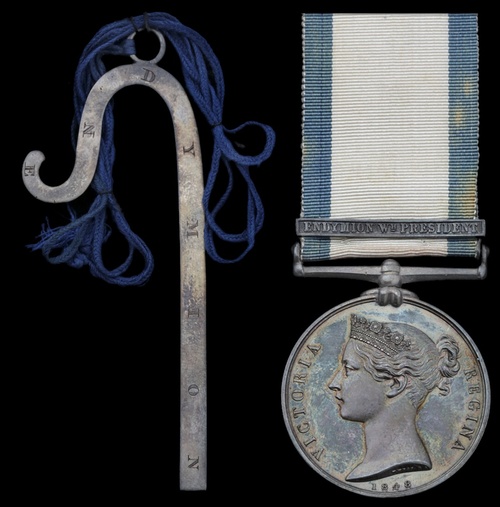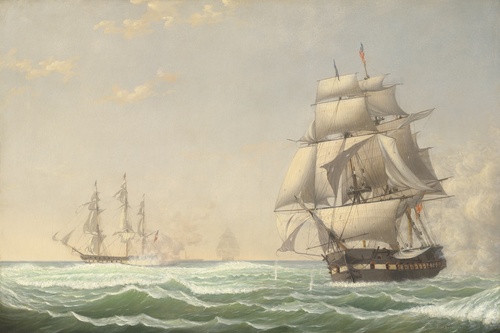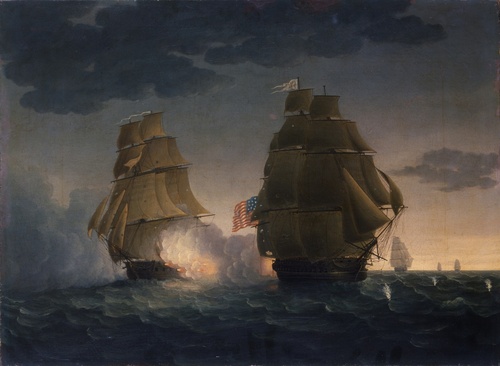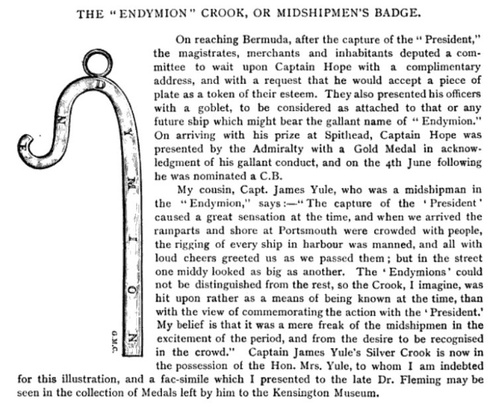Auction: 22002 - Orders, Decorations and Medals
Lot: 50
Sold by Order of a Direct Descendant
The superb Naval General Service Medal and "Midshipman's Badge" awarded to Captain James Yule - late Volunteer First-Class - who participated in the famous frigate battle between H.M.S. Endymion and the U.S.S. President on 14 January 1815, one of the last major naval engagements of the War of 1812 and which led to the celebrated capture of that latter vessel
Naval General Service 1793-1840, 1 clasp, Endymion Wh. President (James Yule.); Midshipman's Badge, silver, hallmarks for London 1814, extremely fine (2)
James Yule, a unique name on the published Roll, is noted variously as "Boy" and "Volunteer 1st Class" on the books of H.M.S. Endymion during that action. Entering the Royal Navy on 20 November 1813, Yule passed his examination for Lieutenant in 1819 but it took a further seven years to be confirmed in that rank, not being promoted until 21 October 1826 - by coincidence the twenty-first anniversary of the Battle of Trafalgar. In later life he served variously with the Coast Guard (1835-1840), before resuming service with the Royal Navy aboard the battleship H.M.S. Monarch (84 guns, Captain Samuel Chambers) as Second - then First - Lieutenant, before being paid-off in 1843. (A Naval Biographical Dictionary, W.R. O'Byrne, refers).
H.M.S. Endymion, a 40-gun frigate and lead ship of her class, served throughout the entirety of the Napoleonic Wars - and even on to the First Opium War; she was known for her exceptional sailing qualities and was one of the fastest frigates in the Royal Navy - a fact which led directly to her famous engagement with the U.S.S. President. On the North American station from July 1813 and under the command of Captain Henry Hope (later Admiral Sir Henry, K.C.B.), Endymion saw much service up and down the east coast of the United States - often in consort with other frigates - capturing trading vessels and privateers and landing men ashore for military expeditions inland.
Opening Moves and Battle Commences
The first days of 1815 found Endymion, Majestic, Pomone and Tenedos off New York, as the blockading squadron for that city. On 14 January the U.S.S. President, a heavy 44-gun frigate commanded by Commodore Stephen Decatur Jr. and which had been bottled-up in port since February 1814, made a break for freedom during a particularly heavy and snowy gale. Things started badly, however, as President ran aground on a sand bar and spent several hours trying to get off - this caused damage to her hull and masts, which Decatur felt necessary to return to port to repair. However, the unfavourable wind direction meant he had no option but to head out to open sea.
Unaware of the location of the British squadron, it was only two hours before sails were spotted on the horizon - Decatur made all sail to escape, but the earlier damage caused to President significantly slowed his ship down. In turn, this allowed Hope's swift-sailing Endymion to come up with the American ship in short order and commenced a running fight at around two o'clock that afternoon.
Aware that American heavy frigates such as President were a force to be reckoned with and had caused much embarrassment to the Royal Navy in the opening years of the War of 1812, Hope had no desire to simply engage the bigger ship broadside-to-broadside and trust to British valour - this is what had previously led to several embarrassing defeats at the hands of the Americans. Instead, he cleverly positioned Endymion on President's starboard quarter, firing into the hull of Decatur's ship in a position at which the American vessel couldn't effectively return fire, and using her famous speed and sailing qualities to nimbly tack and turn whenever his opponent tried to unleash a broadside.
Using this method, Endymion raked President at least three times - the first British broadside alone did terrible execution, wounding Decatur, his First Lieutenant, and another Lieutenant on the quarterdeck; it also helped that Endymion was armed with 24-pounder guns, much heavier than the usual 18-pdrs which for so long had failed to make an impression on the thick-hulled American frigates.
In response to Endymion's shots into the hull, Decatur ordered chain-shot fired at the masts and rigging of his opponent, in an effort to slow down or disable her and escape before the rest of the British squadron were able to come up. In this he was partially successful - the subject of much subsequent controversy.
End Moves
At 7.58pm, President hoisted a light into her rigging and ceased fire - the universal signal at night for surrender. At this, Hope ordered Endymion hove-to in order to affect repairs - especially to the ships' boats, none of which had survived the engagement intact. Decatur, despite having surrendered, then made sail to escape and gained some distance before Hope could follow. However, a short while later the British frigates Pomone and Tenedos caught up with President; the former fired two broadsides into the badly-damaged American, and Decatur struck his colours for the second (and final) time.
Conclusion and Reward
Whereas Captain Lumley in Pomone took physical possession of President, there can be no doubt that Hope and Endymion were the victors of the battle - indeed, Commodore Decatur is recorded as requesting his sword be sent to: "the captain of the black ship" (Endymion; Hope had had her painted entirely black rather than the traditional black with a white/yellow stripe along the gundeck), as he had struck his colours to him alone. The "Butcher's Bill" paid testament to Captain Hope's battle-winning tactics: 35 killed and 70 wounded aboard the President with 11 killed and 14 wounded on Endymion.
Both ships sailed in company to Bermuda (weathering a violent storm in the process) and, whilst there, Hope was presented with a commemorative silver plate by a number of notable inhabitants; it is believed he subsequently used this plate to have commemorative badges made for his 24 officers who participated in the battle - the 'shepherd's crook' format being an allusion to Greek mythology, with one account having Endymion as a handsome shepherd-prince. Hope was later awarded a Gold Medal for this action, in addition to later being made a Companion of the Bath. Endymion and President returned to Britain several months later to much acclaim. Fascinatingly an account of the reception upon their return, by none other than the young Yule, has survived through the years and in which he also mentions his "Midshipman's Badge":
"The capture of the President caused a great sensation at the time, and when we arrived the ramparts and shore at Portsmouth were crowded with people, the rigging of every ship in harbour was manned, and all with loud cheers greeted us as we passed them; but in the street one middy [Midshipman] looked as big as another. The 'Endymions' could not be distinguished from the rest, so the Crook, I imagine, was hit upon rather as a means of being known at the time, than with the view of commemorating the action with the 'President'. My belief is that it was a mere freak of the midshipmen in the excitement of the period, and from the desire to be recognised in the crowd." (Historical Record of Medals and Honorary Distinctions Conferred on the British Navy, Army & Auxiliary Forces From the Earliest Period, G. Tancred, 1891, p.164, refers)
Endymion was finally broken-up in 1868 and President in 1818 - her name, however, lives on to this day as H.M.S. President, the shore-based establishment of the Royal Naval Reserve on the banks of the Thames in central London.
Subject to 20% VAT on Buyer’s Premium. For more information please view Terms and Conditions for Buyers.
Sold for
£13,000
Starting price
£6000











